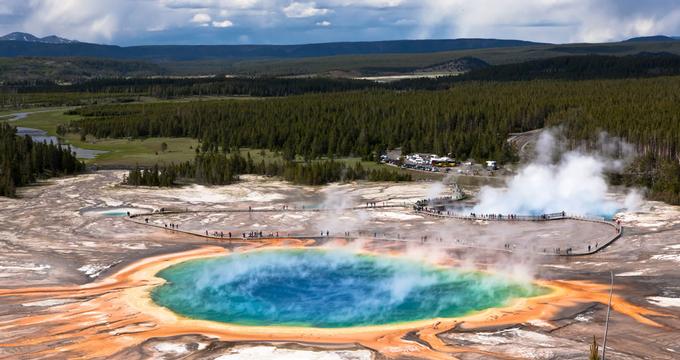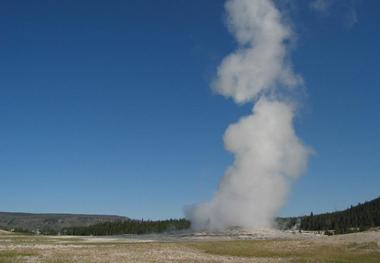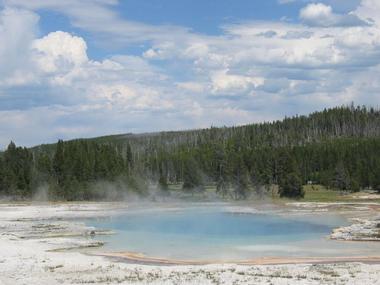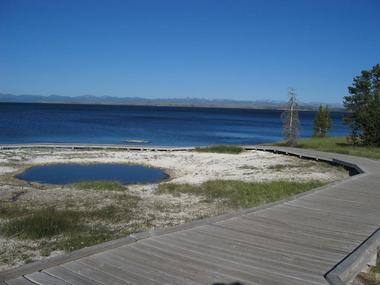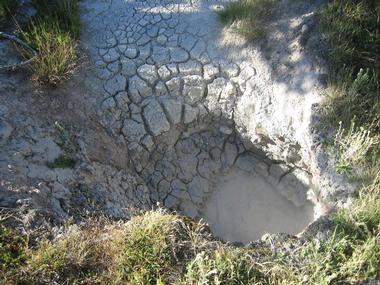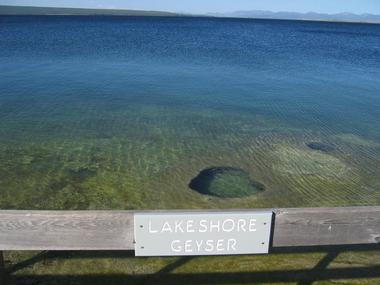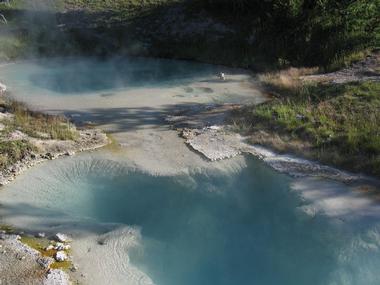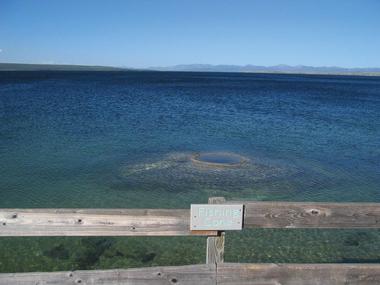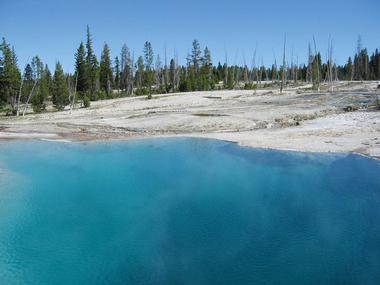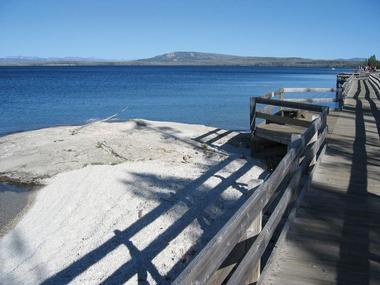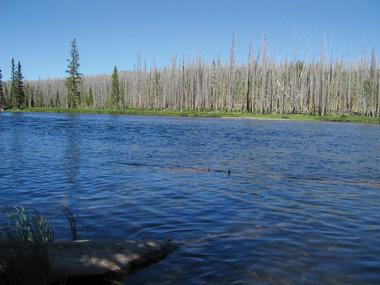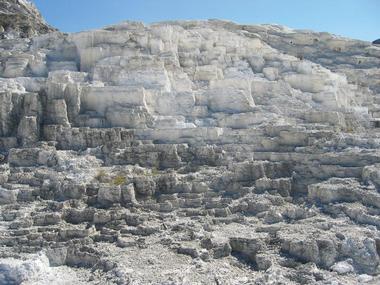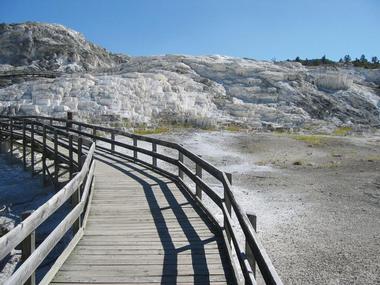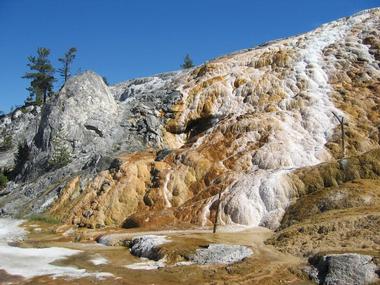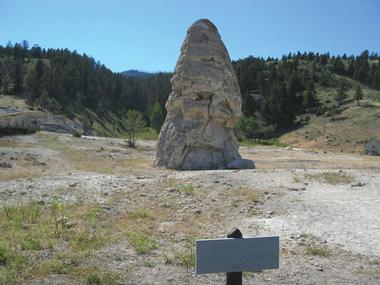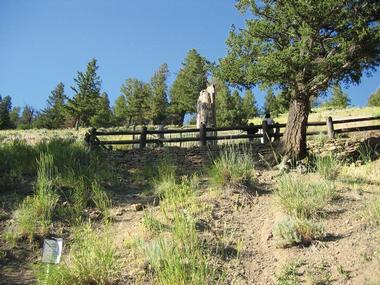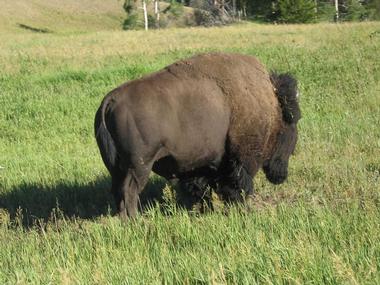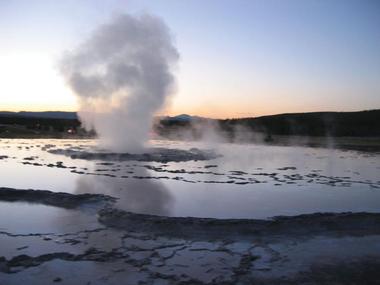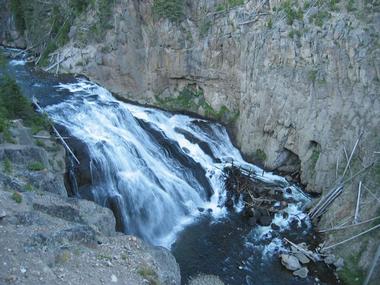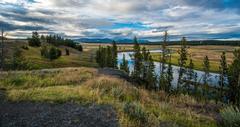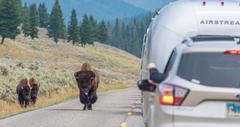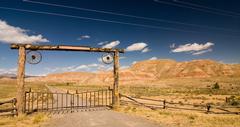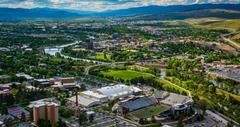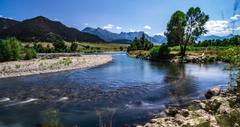Yellowstone National Park encompasses the largest hydrothermal area on the planet. Features include geysers, hot springs, mudpots and fumaroles. Yellowstone was the site of a catastrophic volcanic eruption more than 600,000 years ago. During the eruption, the magma chamber was partially emptied which caused the roof to collapse, forming a giant caldera that covers the bigger portion of Yellowstone National Park.
Today, the magma chamber's partially-molten rock provides heat for Yellowstone's hydrothermal features which are in constant flux. Geysers and colorful terraces in Yellowstone are constantly changing, shaped by thermal activity.
Scenic Drives in Yellowstone
There are two main scenic drives to take in the park, the Lower Loop and the Upper Loop. The Lower Loop highlights include the Upper Geyser Basin with its famous Old Faithful Geyser, Lower Geyser Basin, Firehole River, Gibbon River and Falls, Monument Geyser Basin, Lower and Upper Falls, Yellowstone River, Mud Volcano and West Thumb Geyser Basin. In the summer, each segment of the Lower Loop (Old Faithful to Madison, for example) takes about 45 minutes to drive. In addition to the driving time, you should set aside time for visiting the attractions. Wildlife is abundant in this area, especially elk and bison. Occasionally a bison on the road can cause quite a delay as visitors stop to look at this magnificent animal from the safety of their vehicles.
The Upper Loop features beautiful scenery, exciting wildlife and spectacular hydrothermal features. While Mammoth Hot Springs may be the highlight of the trip for many visitors, other Northern Loop attractions include the Norris Geyser Basin, Blacktail Plateau Drive, the Petrified Tree, Roosevelt Lodge, Undine Falls, Tower Fall, and Lower and Upper Falls. Look for wildlife such as elk and bison, especially early in the morning and in the evening. In the summer, each segment of the Upper Loop (Mammoth Hot Springs to Tower-Roosevelt, for example) takes about 45 minutes to drive. In addition to the driving time, you should set aside time for visiting the attractions. Yellowstone is fun to visit with the family. If you are looking for a quick honeymoon idea in the summer, you can be sure that the magnificent scenery of Yellowstone will help you create a lifetime of memories.
What is Yellowstone known for? What to do. What are the top attractions to visit in Yellowstone?
The top attractions to visit in Yellowstone according to local experts are:
- The Old Faithful and Upper Geyser Basin
- Biscuit Basin
- West Thumb Geyser Basin
- Thumb Paint Pots
- Lakeshore Geyser and Lakeside Spring
- Seismograph and Bluebell Pools
- Fishing Cone
- Black Pool Is Bright Blue in Color
- Yellowstone Lake
- The South Entrance Offers a Dramatic Way into Yellowstone
- Mammoth Hot Springs - Tips for Travelers
- Minerva Terrace
- The Colorful Palette Spring
- Liberty Cap
- Petrified Tree in Yellowstone
- Wildlife Watching along the Blacktail Plateau Drive
- Romantic Sunset at the Great Fountain Geyser
- Undine Falls and The Upper Falls
Yellowstone Travel Tips
Yellowstone National Park is a unique vacation destination just north of Grand Teton National Park. The park is situated at high altitude and most visitors will need a couple of days to adjust to the change. Initially, plan to take short walking trips and on warm summer days drink plenty of fluids. Since the sun is very strong at high altitude, wear a hat and sunscreen. The weather can change quickly from clear skies to a thunderstorm. As a rule of thumb, each road segment takes about 45 minutes to drive by car. In the summer, repairs are often underway which can cause delays. Visitor centers have the latest information about road conditions. When you enter the park, you will receive a map and a newspaper with the latest news. Each major area, such as the West Thumb Geyser Basin, features ranger-led walks, adventure hikes and other visitor services. Summer is peak season. Park roads and entrances are least crowded before 11 am and after 4 pm. In addition to camping, there are several hotels and lodges in the park. There are numerous vacation activitiesto choose from, including fishing, boating, hiking, horseback riding and wildlife watching.
- What's the Weather Like?: This area is at high altitude, over 7,500 feet (2,275 meters). In the summer, daytime temperatures are in the 70s and 80s, while at night temperature can drop to below freezing. Thunderstorms are frequent on summer afternoons. Winters are very cold with daytime temperatures from zero to 20F and sub-zero temperatures at night. Snowfall average is about 150 inches per year. In the spring and fall, daytime temperatures range from the 30s to the 60s, and snow is common.
- Wildlife Watching Tips and Ideas: Yellowstone is famous for the abundance of its wildlife, including bison, elk, wolves, bears, coyotes, moose, bobcats, mountain lions and an array of unique birds. Each species has a preferred habitat, but sightings are unpredictable. Visitors should exercise caution near wild animals and never approach them on purpose as their behavior is unpredictable. Yellowstone visitor centers provide educational information about wildlife that every first time park visitors should learn about.
- Spotting Bison: There are about 3,600 bison in Yellowstone National Park. They wander around the park's grassy areas in the summer and winter around geyser basins where they find warmth and shelter. The largest mammals in the park, bison are vegetarian. Males can weigh more than 1,800 pounds. Despite their massive size, they can move quickly and can harm people who get in their way. Despite ranger warnings, we've seen tourists get out of their car with a video camera and approach bison too close for comfort. The best way to watch bison it through binoculars or from your car if they are near the road. On Blacktail Plateau Drive you can often spot bison and observe them safely from your car in the summer months.
- How to Help Prevent Wildfires: Fires are an essential player in the development of Yellowstone's ecosystems. While some are caused by men, most occur naturally when lightning strikes. When you drive through acres and acres of Yellowstone that were destroyed by wildfire, you realize what a landscape-changing event this is. Certain species of trees such as lodgepole pine need the heat to open their cones to release the seeds. The largest fires in the recent history took place in the summer of 1988. About 1/3 of the park’s area was burned and several structures were destroyed as the fires could not be contained. Today, park visitors can see the effects everywhere, although both plant and animal populations have recovered quickly. Following the 1988 fire, management plans for national parks and forests were revised across the nation. Naturally occurring fires are allowed to burn today under stricter guidelines.
Yellowstone Lodging
There are nine unique lodges and hotels, all operated by Xanterra Hotels and Resorts. Most park accommodations are historic and located near major attractions. Mammoth Hot Springs Hotel and Old Faithful Snow Lodge are the only accommodations that remain open in the winter. All reservations for Yellowstone accommodations can be made through Xanterra. Call 307-344-7311 or visit www.travelyellowstone.com.
- Old Faithful Inn: The Old Faithful Inn, a national historic landmark, is a rustic lodge situated near the famous Old Faithful geyser. It also features a restaurant and gift shop. The Old Faithful area is also home to Old Faithful Lodge Cabins and Old Faithful Snow Lodge & Cabins, the newest hotel completed in 1999.
- Lake Yellowstone Hotel: Lake Yellowstone Hotel is the oldest hotel in the park, originally built in 1891 and restored in 1990. Hotel rooms are designed in historic 1920s style. Lake Yellowstone Hotel is situated on the shore of Yellowstone Lake, while Lake Lodge Cabins are located nearby.
- Roosevelt Lodge Cabins: Roosevelt Lodge Cabins, named after Theodore Roosevelt, are rustic cabins located near Tower-Roosevelt.
- Mammoth Hot Springs Hotel: Mammoth Hot Springs Hotel is the only lodging facility accessible by car in the winter. Visitors enjoy snowshoeing, ice skating and skiing in the area surrounding the hotel.
- Canyon Lodge & Cabins: Canyon Lodge & Cabins are located near the Grand Canyon of the Yellowstone. The area offers hiking and horseback riding.
- Grant Village: Grant Village, named after president Ulysses S. Grant, is a large complex built in 1984 with 6 two-story buildings, each containing 50 rooms. There are also two restaurants with scenic views of the lake, a lounge and a gift shop.
You are reading "25 Best Things to Do in Yellowstone " Back to Top
Airports Near Yellowstone National Park
Yellowstone National Park is one of the most famous natural wonders of the United States. Set atop a volcanic field, the park is known around the world for being the home to all kinds of animals, including those species that are almost synonymous with the American Frontier. Some include bison, wolves, and bears.
Jackson Hole Airport (JAC)
As its name hints, Jackson Hole Airport is located in Jackson, Wyoming. Actually, it’s some seven miles to the north of the city center, which is a good thing if you’re planning to go to the national park straight after landing. It’s because the airport is less than 4 miles away from the Grand Teton National Park and about 80 miles away from Yellowstone Lake.
In fact, Jackson Hole Airport is the only commercial airport located inside the boundaries of a US national park. That makes it the best choice for those who want to get to the park as quickly as possible. Truth be told, there are many people who want that. The annual traffic of this airport is over 300 thousand passengers, which is pretty impressive, especially considering that the total population of Wyoming is less than 580 thousand people.
The airport offers a non-stop service from and to 13 different destinations in the United States. This includes the cities like New York City (JFK Airport), Los Angeles (LA International Airport), and Chicago (O'Hare Airport). Unfortunately, direct flights from these cities aren’t too affordable. For example, if you want to get to the Jackson Hole Airport straight from Chicago, you will need to pay over 400 for a one-way ticket.
That’s why it might be wise to look for better deals even if they involve some stops along the way. You can look for them at sites like SkyScanner. To find Jackson Hole Airport deals, make sure to use the airport code JAC.
Yellowstone Regional Airport (COD)
Here’s another airport located in the state of Wyoming. The airport is only about 53 miles away from the entrance of the park (East Entrance of Yellowstone Park). It’s also very close to the city of Cody, where you can find companies that offer guided tours to the park.
Speaking of Cody, the city is the actual owner of the airport. At the moment, only two airlines are operating this airport – Delta Connection, with Salt Lake City as the only destination, and United Express, which takes passengers to and from Denver and Chicago.
Yellowstone Airport (WYS)
If you are planning to enter Yellowstone National Park through the state of Montana, you have several airports at your disposal. One of those is the Yellowstone Airport with the airport code WYS. The airport is about a mile away from the town of West Yellowstone, which is situated right on the border of the park, at the West Entrance.
The airport is open only during summer, that is, from June through September. During those four months, it is served by Delta Connection, which connects it with Salt Lake City Airport (SLC).
Billings Logan International Airport (BIL)
Billings Logan International Airport is the second-busiest airport in Montana, with nearly 400 thousand passengers on a yearly basis. As its name suggests, the airport is located near the state’s largest city, Billings. The distance from the city center to the entrance to the park is about 65 miles.
This airport is served by several airlines, which connect it to a number of airports across the United States, including those located in Salt Lake City, Dallas, Denver, Seattle, and so on.
Yellowstone International Airport (BZN)
In 2013, this airport overtook Billings Logan International Airport as the busiest airport in the state. It’s estimated that it has over 400 thousand passenger boardings each year. As of April 2018, the airport is served by five different airlines – Alaska Airlines, Allegiant Air, American Airlines, Delta Air Lines, Frontier Airlines, and United Airlines.
Some of the destinations covered by these airlines include Seattle, Las Vegas, Dallas, Minneapolis/St. Paul, Denver, Chicago, Los Angeles, and so on. The airport seems like a pretty convenient solution for those who wish to visit Yellowstone, as it’s located in Belgrade, a town that’s only 80 miles away from the entrance to the park.
Idaho Falls Regional Airport (IDA)
For those of you who are going to Yellowstone National Park through Idaho, the Idaho Falls Regional Airport in Bonneville County seems like the best solution. Only one airport in the state has more annual boarding passengers than the IDA.
But, unlike the busiest airport in Idaho, this one is pretty close to Yellowstone. In fact, the distance between the airport and the nearest park entrance is about 70 miles. If you want to enter Yellowstone through its West Entrance, you will have to cover a distance of a little bit over 100 miles.
There are three airlines that serve this airport. Allegiant Air offers direct flights to Las Vegas and Phoenix throughout the year, while Oakland and Los Angeles are the destinations that are available only at certain times of the year. Delta Connection is an airline that connects the airport to Salt Lake City, as well as Minneapolis/St Paul, although the flights to Minnesota are available only seasonally. United Express offers only seasonal flights from Idaho Falls Regional Airport to Denver International.
Yellowstone is the place where tourists come to see breathtaking views of canyons, rivers, and geysers. In fact, there are so many amazing things at the park that visiting it is a must, even if you’re not a big environmentalist. It’s not a surprise that Yellowstone has something for everyone, considering that it stretches over a massive area, which crosses the borders of several states – Wyoming, Idaho, and Montana.
Speaking of its size, the park covers an area of over 2.2 million acres (approx. 3,500-sq.miles). That said you should know that you can enter the park from many different entrances. If you are planning to get in through the South entrance, your best choice is to go via Jackson Hole Airport.
You are reading "25 Best Things to Do in Yellowstone " Back to Top
Hotel Spotlight: Hotel Terra Jackson Hole
Located in the heart of Teton Village in Wyoming, the Hotel Terra is an award-winning hotel that offers a quintessential Jackson Hole retreat. Situated next to the ski lifts at Jackson Hole Mountain Resort and just a few miles from the Grand Teton National Park, the upscale hotel features deluxe accommodations with contemporary décor, en-suite bathrooms, and modern conveniences such as iPod docking stations, coffee makers, and flat-screen cable televisions. Upgraded rooms and suites add multiple bedrooms and separate sitting areas with fireplaces, fully equipped kitchenettes, and private balconies or terraces with spectacular views. Premier amenities include a rustic Italian restaurant and elegant lobby bar and lounge, a heated outdoor infinity pool and fitness center, a rooftop spa that offers indulgent treatments and two hot tubs with beautiful mountain views. Hotel Terra is ideally located for exploring all that Jackson Hole and the surrounding area has to offer from hiking, mountain biking, horseback riding, skiing, snowboarding, and more.
Guest Accommodations
Hotel Terra offers a variety of stylishly appointed and decorated guest rooms and suites, ranging from Terra Guest Rooms and Urban Studios to One-, Two-, and Three-Bedroom Suites. All guest rooms and suites boast contemporary décor and modern furnishings with feature king or queen-size pillow-top beds dressed in deluxe linens, down comforters, and hypoallergenic pillows, and en-suite bathrooms with walk-in showers, soaking tubs, heated floors, double vanities, cotton towels and bathrobes, and branded bath products. Modern amenities include air-conditioning, LCD televisions with cable channels, iPod docking stations, coffee makers, mini-fridges, alarm clocks, hairdryers, irons and ironing boards, telephones with voicemail services, and complimentary wireless Internet.
Terra Guest Rooms exude modern elegance and refined finishes with spacious entry foyers, high ceilings, and oversized windows with breathtaking views. These comfortable rooms offer one king, or two queen-size beds dressed in deluxe linens, down comforters, and hypoallergenic pillows, and en-suite bathrooms with heated floors, double vanities, deep soaking Zuma air-tubs, rain showers, 100% cotton towels and bathrobes, and branded bath products. Modern amenities include air-conditioning, LCD televisions with cable channels, iPod docking stations, coffee makers, mini-fridges, alarm clocks, hairdryers, irons and ironing boards, telephones with voicemail services, and complimentary wireless Internet.
Urban Studios are cozy, apartment-style rooms that offer multi-functional spaces that open onto furnished terraces with lovely views. These stylish studios have fully equipped kitchens with appliances and utensils, dining areas with tables and chairs for entertaining, and generous living areas with plush seating and inlaid gas fireplaces. Studios have custom-designed wall beds dressed in deluxe linens, down comforters, and hypoallergenic pillows, and en-suite bathrooms with heated floors, double vanities, deep soaking Zuma air-tubs, rain showers, 100% cotton towels and bathrobes, and branded bath products. Modern amenities include air-conditioning, LCD televisions with cable channels, iPod docking stations, coffee makers, mini-fridges, alarm clocks, hairdryers, irons and ironing boards, telephones with voicemail services, and complimentary wireless Internet.
One-, Two, and Three-Bedroom Suites are chic and stylish with contemporary décor and modern furnishings and combine the ambiance of a luxury hotel with the comforts found in an upscale apartment. These suites have fully equipped kitchens, spacious dining areas with tables and chairs for up to six guests, and ample living rooms with plush seating and modern amenities. Bedrooms have king or queen-size pillow-top beds dressed in deluxe linens, down comforters, and hypoallergenic pillows, and one, two or three en-suite bathrooms with walk-in showers, soaking tubs, heated floors, double vanities, cotton towels and bathrobes, and branded bath products. Living areas open onto furnished terraces with spectacular views.
Dining
A complimentary breakfast is served every morning and includes coffee, tea and hot beverages, fresh fruit and juices, cereals, granolas and yogurts, egg dishes, and freshly baked pastries, and bread. The hotel is home to Il Villaggio Osteria, a rustic Italian restaurant that serves authentic Italian cuisine in a laid-back and relaxed atmosphere, and the Bar Enoteca, where guests can enjoy handcrafted cocktails, signature spirits, artisanal beers and fine wines from around the world.
Amenities and Recreation
Premier facilities include a rustic Italian restaurant and elegant lobby bar and lounge, a heated outdoor infinity pool and fitness center, a rooftop spa that offers indulgent treatments and two hot tubs with beautiful mountain views. A complimentary breakfast is served every morning in the elegant dining room, and signature cocktails and drinks can be enjoyed at the Bar Enoteca and lounge or on the outdoor terrace.
Weddings & Events
The Hotel Terra offers a magical venue for weddings, receptions, and other special celebrations with perfectly manicured grounds, deluxe accommodations, gourmet breakfasts and dinners, and friendly, helpful staff. The hotel also offers professional services include event planning and management, award-winning catering services, décor and setup, entertainment, music and audiovisual equipment.
3335 Village Drive, Teton Village, WY 83025, Phone: 307-201-6065
More Wyoming vacations


